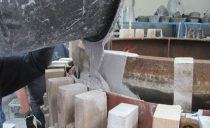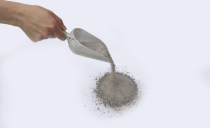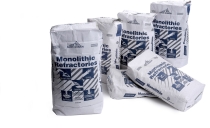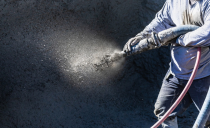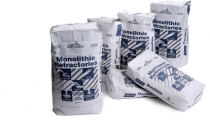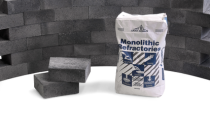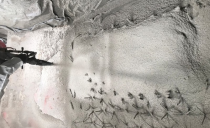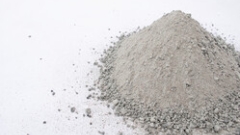
Que sont les produits réfractaires monolithiques ?
Les produits réfractaires monolithiques jouent un rôle important dans de nombreuses industries et processus en raison de leur polyvalence et de leurs propriétés uniques. Par définition, il s'agit de matériaux réfractaires non moulés qui peuvent être façonnés dans n'importe quelle forme souhaitée, ce qui offre plusieurs avantages par rapport aux options traditionnelles. Certains des premiers réfractaires monolithiques ont été utilisés en mélangeant des agrégats réfractaires avec de la chaux et de l'eau, ce qui a conduit au développement de bétons réfractaires liés au ciment et d'autres matériaux monolithiques.
Les produits réfractaires monolithiques sont principalement utilisés dans diverses applications dans les cimenteries, la construction, la métallurgie ferreuse et non ferreuse et les usines pétrochimiques, car ils sont disponibles sous différentes formes et peuvent être moulés pour répondre à des exigences spécifiques. Cet article de blog présente une vue d'ensemble des produits réfractaires monolithiques, de leurs propriétés et de leurs principaux avantages.
Types de réfractaires monolithiques et méthodes de mise en œuvre
Les réfractaires monolithiques sont disponibles sous plusieurs formes, chacune présentant des propriétés et des avantages uniques. Ces formes comprennent les bétons coulables, les ciments vibrés à sec, les mortiers, les bétons damés et les mélanges pour les méthodes de mise en œuvre par projection et par gunitage, que nous examinerons plus en détail ici.
Bétons
Ces matériaux réfractaires monolithiques sont composés de grains réfractaires fins et grossiers calibrés avec précision et d'un système liant. Après avoir été moulés dans des formes spécifiques adaptées à un large éventail d'applications, les revêtements ou échantillons correspondants sont chauffés à haute température. Les bétons sont fréquemment utilisés dans les fours, les incinérateurs et les réacteurs, pour les moules de production de verre et de métal, etc.
Ciments vibrés secs
Ces matériaux réfractaires monolithiques sont issus d'une sélection rigoureuse de grains purs et fins qui sont installés sous vibration sans ajout d'eau. Ce système complexe repose sur la transformation des phases du mélange à différentes températures clés tout au long du processus d'application. Le matériau fritté présente une excellente résistance à la corrosion et une excellente stabilité dimensionnelle, ce qui permet de réaliser des économies et d'améliorer la sécurité des opérateurs.
Mortier
Le mortier réfractaire est utilisé pour assembler ou réparer des briques et des tuiles dans des applications à très haute température. Il est conçu à partir de poudres réfractaires, de liants et d'eau afin de répondre aux exigences des clients. Le mortier, appliqué entre les briques ou les tuiles, est utilisé pour garantir que l'assemblage résiste aux propriétés de dilatation thermique de la maçonnerie globale et pour maintenir une haute résistance à la corrosion par les métaux chauds.
Compactage
Le compactage est une autre méthode d'application des matériaux monolithiques. Le processus consiste à compacter le matériau à l'aide d'un compacteur, ce qui permet d'obtenir les propriétés thermomécaniques appropriées pour l'application finale.
Béton projeté
Le béton projeté est un béton ou un mortier utilisé pour la construction ou la réparation rapide de ponts, de bâtiments, de réservoirs de stockage et d'autres constructions. Il est mélangé selon un procédé à sec ou humide avant d'être appliqué à grande vitesse sur la surface souhaitée, ce qui réduit le temps d'arrêt pour réparation et améliore les performances pendant les opérations de fusion.
Projection
La projection est une méthode utilisée pour appliquer des matériaux monolithiques à des fins de revêtement et de réparation. Le processus consiste à pulvériser le matériau souhaité sur la surface d'un composant afin de former un revêtement d'une épaisseur comprise entre 10 et 30 mm. Les matériaux de projection sont composés d'agrégats réfractaires, de liants et d'eau, et sont utilisés dans des applications à haute température, telles que les industries métallurgiques et de production d'électricité.
Propriétés des réfractaires monolithiques
Les réfractaires monolithiques possèdent plusieurs propriétés qui leur confèrent des performances supérieures dans toute une série d'applications industrielles. Ces propriétés comprennent l'inertie chimique, la résistance aux températures élevées, la résistance à l'abrasion, la résistance aux chocs thermiques et la résistance à la corrosion.
● Inertie chimique : cela signifie qu'ils ne réagissent pas avec les matériaux corrosifs ou réactifs.
● Résistance aux températures élevées : ils peuvent supporter des températures allant jusqu'à 1 800 °C (3 272 °F).
● Résistance aux chocs thermiques : les changements brusques de température n'ont aucun impact sur ces matériaux.
Ces propriétés contribuent à leur grande durabilité et à leurs performances supérieures, ce qui en fait des matériaux idéaux dans les environnements chimiques difficiles et à haute température. Ils peuvent résister à l'usure mécanique, ne se corrodent pas et ne rouillent pas au contact de produits chimiques ou d'autres matériaux corrosifs, et fonctionnent bien sous vide ou sous pression.
Quels sont les avantages des réfractaires monolithiques ?
Les réfractaires monolithiques offrent de nombreux avantages par rapport aux matériaux traditionnels, notamment une facilité d'installation, des revêtements sans joints, des performances exceptionnelles et une grande polyvalence dans les secteurs industriels.
Facilité d'installation
Les matériaux réfractaires monolithiques sont plus faciles et plus rapides à installer que les briques réfractaires, ce qui réduit les coûts pour les entrepreneurs. Ils peuvent être installés par coulée, vibration, cimentation, projection ou compactage, selon le type de matériau utilisé.
Revêtements sans joints
Comme ces matériaux ne comportent aucun joint ni raccord, cela réduit considérablement le risque de corrosion et de choc thermique. Un autre avantage des revêtements sans joints est qu'ils sont plus faciles à nettoyer, ce qui permet d'économiser du temps et de l'argent en matière d'entretien.
Performances exceptionnelles
Les réfractaires monolithiques surpassent les briques réfractaires traditionnelles grâce à leur résistance à l'abrasion, à la corrosion et aux chocs thermiques. Ces propriétés contribuent à une durée de vie plus longue et plus régulière.
Polyvalence dans les applications industrielles
Les réfractaires monolithiques possèdent des propriétés exceptionnelles qui leur permettent de résister à des environnements chimiques difficiles, à des pressions et à des températures élevées. Ils conviennent donc à un large éventail d'applications et d'industries.
Où puis-je acheter des matériaux réfractaires monolithiques ?
Saint-Gobain Performance Ceramics and Refractories propose une gamme de matériaux réfractaires monolithiques hautement performants pour les conditions de fonctionnement les plus extrêmes. Nous fournissons généralement des solutions pour les fours and fourneaux, la métrologie, la production de métaux ferreux et non ferreux ainsi que de nombreuses autres applications exigeantes. Notre gamme de produit comprend des bétons coulables, du ciment sec vibré, du mortier, des produits de ragréage, du béton projetéc, ainsi que des mélanges à projeter et à damer.
Contactez dès maintenant un membre de notre équipe pour en savoir plus sur les matériaux réfractaires monolithiques et leurs applications.
Contenu similaire
Ciments
La gamme de coulables de Saint-Gobain Performance Ceramics and Refractories ne se limite pas aux ciments courants mais aussi à des spécialités telles que...
NORVIBE™ Ciments secs vibrés
Les ciments secs vibrés NORVIBE™ sont conçus pour une facilité d'installation, une durée de vie exceptionnelle et une résistance optimale à la corrosion...
Mortier
Les produits de mélanges de mortiers et ciments réfractaires de Saint-Gobain Performance Ceramics & Refractories ont été développés pour répondre aux...
Masses à damer
La gamme de mélanges de pilonnage humides et secs de Saint-Gobain Performance Ceramics & Refractories est adaptée pour s'adapter à un large éventail d...
Béton projeté
La gamme de mélanges pour béton projeté de Saint-Gobain Performance Ceramics & Refractories comprend des systèmes de collage optimisés pour réduire le...
Gunitage
Saint-Gobain Performance Ceramics & Refractories propose une large gamme de mélanges de gunitage conçus pour l'entretien et la réparation des fours.
Refrax ProMor et PLUSflow - Mortier
Découvrez Refrax® ProMor et PLUSflow Mortiers - l'épine dorsale de ses systèmes de carrelage pour les applications de valorisation énergétique.
Firefrax CRM-30 et Carbofrax - Mortiers
Découvrez la gamme complète de mortiers de spécialité de Saint-Gobain Performance Ceramics & Refractories pour fours cuivre.
Réparations rapides
Découvrez la gamme de solutions polyvalentes de Saint-Gobain Performance Ceramics & Refractories pour des réparations rapides à chaud.
